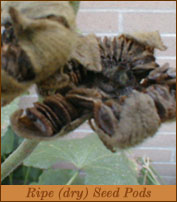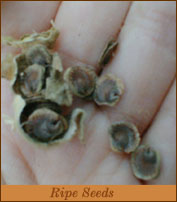 There are a variety of reasons for harvesting your own seeds; some personal, some environmental. Perhaps you have a variety that you like and you are concerned that seed companies may discontinue stocking it. You saw some wildflowers while on an outdoor hike that you’d like to grow in your own garden. You have a heritage variety and you want to continue growing it in future years. You want to trade some of your seeds with some of a friend’s seeds, you want to grow organic seeds, or maybe you just want to save money and avoid buying new annuals next year. Whatever the reason, you don’t need to be a botanist or a farmer to do it. If you can grow plants, you can produce your own seeds. There are however, a few things you may want to know before you get started.
There are a variety of reasons for harvesting your own seeds; some personal, some environmental. Perhaps you have a variety that you like and you are concerned that seed companies may discontinue stocking it. You saw some wildflowers while on an outdoor hike that you’d like to grow in your own garden. You have a heritage variety and you want to continue growing it in future years. You want to trade some of your seeds with some of a friend’s seeds, you want to grow organic seeds, or maybe you just want to save money and avoid buying new annuals next year. Whatever the reason, you don’t need to be a botanist or a farmer to do it. If you can grow plants, you can produce your own seeds. There are however, a few things you may want to know before you get started.
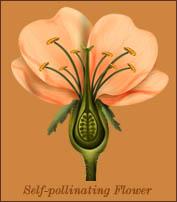 Plants either have all the parts to pollinate themselves, (called self-pollinators) or they are aided in accomplishing this by insects, the wind, or human intervention (cross-pollinators). Self-pollinators are commonly referred to as ‘perfect flowers’ as they contain all the parts to successfully pollinate themselves. The comparatively imperfect cross-pollinators produce all the parts to pollinate, but not all in one place. Parts are divided between blooms or are ‘self-incompatible’, identifying their own pollen as foreign material. Pollen must find its way from one plant to the next. This method is preferable for the survival of the species because it ensures that the plants produce genetically diverse seeds– seeds that contain different genetic information or traits then the original plant. This enables the plant to better adapt itself to the environment it is in, or acquire traits that will help it become more disease resistant. Self-pollinators on the other hand, essentially produce clones, which makes them more susceptible to any problems that may arise.
Plants either have all the parts to pollinate themselves, (called self-pollinators) or they are aided in accomplishing this by insects, the wind, or human intervention (cross-pollinators). Self-pollinators are commonly referred to as ‘perfect flowers’ as they contain all the parts to successfully pollinate themselves. The comparatively imperfect cross-pollinators produce all the parts to pollinate, but not all in one place. Parts are divided between blooms or are ‘self-incompatible’, identifying their own pollen as foreign material. Pollen must find its way from one plant to the next. This method is preferable for the survival of the species because it ensures that the plants produce genetically diverse seeds– seeds that contain different genetic information or traits then the original plant. This enables the plant to better adapt itself to the environment it is in, or acquire traits that will help it become more disease resistant. Self-pollinators on the other hand, essentially produce clones, which makes them more susceptible to any problems that may arise.
Be aware that if you want cross-pollination to occur in your garden, you need to make your garden favorable to pollinating insects or be prepared to do all the pollinating yourself. Grow plants nearby that attract pollinators–butterfly bush, Queen Anne’s lace, bee balm, salvia, and cleome are a few, and avoid using chemical sprays that will kill all insects both harmful and beneficial.
In some cases you might want to keep cross-pollination from taking place. Plants that are closely related, for example different varieties of melons, will cross-pollinate producing seeds that are a mix of the two varieties. If you want to keep your varieties true, plant similar species of plants on opposite ends of your garden.
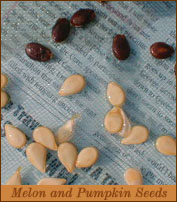 Open Pollenated, Heirloom, and Hybrid
Open Pollenated, Heirloom, and Hybrid
Before you decide to save the seeds from a particular plant you will need to know whether they are Open-pollinated, Heirloom or Hybrid. Open-pollinated plants are those pollinated–naturally or through human intervention–by the same species of plant. Heirlooms are older plant varieties that have maintained relatively unchanged in a particular region for several generations, and all are open-pollinated. Hybrids are plants that have been cross-pollinated using two different species of the same genus of plant. They are bred professionally under controlled conditions, to produce certain desirable traits. Grocery store produce is usually hybridized and often bred for mass production or large-scale farming. Many of the characteristics that are bred into these plants, such as thick skins for transport, or high water content for size, are not desirable for small-scale gardening. This is one reason why you may not want to save seeds from store bought produce. Seed packaged for the home gardener by seed companies may also be hybridized. These plants are bred to contain traits that are desirable to the small scale gardener such as colour and taste. However, seeds produced by these hybrids doesn’t guarantee that those desirable traits will be carried over to the next generation. In most cases the such traits may actually disappear entirely after a few generations. Or the seeds may be sterile and won’t produce fruit anyway. Either way, growing seeds from hybrids is a gamble. Checking the seed packet or catalogue of the grower is one way to find out whether seed are hybrids. Packets will often say F1 to indicate hybrids or OP to indicate open-pollinated.
If this will be your first time saving seeds, start out with some easy plants that flawlessly produce seeds without any intervention. Annuals such as cosmos, marigolds, pansies, corn flowers and many others are some of the easiest. Collect seeds from the highest quality and healthiest plants. A good specimen is disease and pest free, has bright foliage and flowers, and grows vigorously.
Under usual circumstances snipping flower heads off after they are spent (deadheading) is crucial to encouraging a plant to continue producing new flowers. To save seed, leave the flowers on the stem after the flower dies off instead. That way, the plant will start putting its resources into producing seed instead of new flowers.
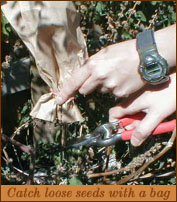 Before long a seedpod will replace the spent flower. Don’t remove the seed head right away: leave it on the stems as long as possible, letting it ripen within the pod. Seeds are generally ready when the pod turns brown, dries out or cracks open. If you notice that the seed pod is prone to cracking open on it’s own (snapdragons, violas, pansies), attach a lunch-sized paper bag around it using an elastic or string, catching the seeds as they fall. When the seeds are fully ripe, cut the stem at the base of the plant and shake the seed head inside the bag to dislodge the seeds from the casing. If some seeds are lost to the soil they will come up on their own next year. This is called self-seeding, and many annuals reproduce themselves this way.
Before long a seedpod will replace the spent flower. Don’t remove the seed head right away: leave it on the stems as long as possible, letting it ripen within the pod. Seeds are generally ready when the pod turns brown, dries out or cracks open. If you notice that the seed pod is prone to cracking open on it’s own (snapdragons, violas, pansies), attach a lunch-sized paper bag around it using an elastic or string, catching the seeds as they fall. When the seeds are fully ripe, cut the stem at the base of the plant and shake the seed head inside the bag to dislodge the seeds from the casing. If some seeds are lost to the soil they will come up on their own next year. This is called self-seeding, and many annuals reproduce themselves this way.
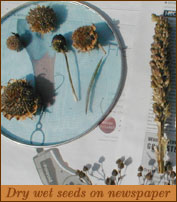 If the seed heads are not fully dry and ripe when you cut them off, either hang the stems (with the seed cases) or lay them flat to dry on a newspaper or paper towel pad away from direct light. Make sure that all seeds are completely dry before removing them from the pods: if you package them before they are fully dry they will go moldy in storage. This is the simplest way; it’s easier to dry the whole seed head then a bunch of loose seeds. When the pod is dry, extract the seeds by carefully crushing or breaking open the seedpods. Separate crushed debris from the seeds by sifting everything through a fine mesh screen. The debris will fall through and the seeds will remain on top of the screen. Some seeds such as those from marigolds or black-eyed susans can simply be pulled from the seed head.
If the seed heads are not fully dry and ripe when you cut them off, either hang the stems (with the seed cases) or lay them flat to dry on a newspaper or paper towel pad away from direct light. Make sure that all seeds are completely dry before removing them from the pods: if you package them before they are fully dry they will go moldy in storage. This is the simplest way; it’s easier to dry the whole seed head then a bunch of loose seeds. When the pod is dry, extract the seeds by carefully crushing or breaking open the seedpods. Separate crushed debris from the seeds by sifting everything through a fine mesh screen. The debris will fall through and the seeds will remain on top of the screen. Some seeds such as those from marigolds or black-eyed susans can simply be pulled from the seed head.
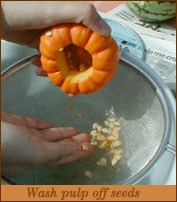 Seeds from fruits and vegetables should be collected when plants are at their peak, before they are over-ripe and decay has set in. Some vegetables such as beans are the exception and should be harvested when the pods are dry. Seeds from most fruits and vegetables are incased inside a wet environment (the part usually eaten). In the case of very wet pulp such as tomatoes, the seeds can be washed from the pulp and then laid out to dry on newspaper or a screen. The same can be done with pumpkins, squash and other soft pulp vegetables. In the case of harder pulp fruits and vegetables they are simply opened up and the seeds removed manually.
Seeds from fruits and vegetables should be collected when plants are at their peak, before they are over-ripe and decay has set in. Some vegetables such as beans are the exception and should be harvested when the pods are dry. Seeds from most fruits and vegetables are incased inside a wet environment (the part usually eaten). In the case of very wet pulp such as tomatoes, the seeds can be washed from the pulp and then laid out to dry on newspaper or a screen. The same can be done with pumpkins, squash and other soft pulp vegetables. In the case of harder pulp fruits and vegetables they are simply opened up and the seeds removed manually.
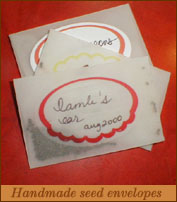 Storing Seeds
Storing Seeds
The best way to store seeds is to package them in paper envelopes or bags since they allow for good air circulation and don’t sweat. However, any container will do, keeping in mind that humidity and lack of air circulation will cause mold, disease and prompt seeds to germinate prematurely. Film canisters for one aren’t recommended as the plastic promotes humidity and stagnant air. The temperature should be cool to make longer storage possible-refrigerator storage will work if you can’t find a naturally cool place. Be sure to write the date, name of plant and any growing instructions you are aware of on the envelope or package. This will come in handy when using the seeds a year or more later, and will be appreciated if you give the seeds to someone else. It’s worth it (but not necessary) to put a bit of extra effort into the packaging if the seeds are to be given away. Use specialty papers for the envelopes or create fancy labels to mark them. Some envelope and label templates are provided here for you to print out on any paper (or sticker paper for labels that is compatible with your printer type).
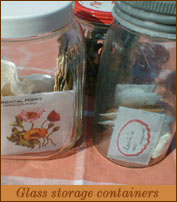 Store seeds carefully by placing envelopes inside large glass jars with a bag of silica or powdered milk. These products absorb excess moisture. Reuse the tiny bags of silica gel that come inside new shoes–dry them for a few minutes at a very low temperature in your oven. Alternatively, make a tiny package of powdered milk by pouring a pile into the centre of a piece of breathable fabric or tissue paper. Pull the corners together and close it up with a piece of string or elastic to create a sachet. The best jars for storage are wide mouth mason jars used for canning. They have the proper airtight seal that is essential for long term storage. If you store the jars in a cool, dark place the seeds should last from a year to a few years, depending on the type.
Store seeds carefully by placing envelopes inside large glass jars with a bag of silica or powdered milk. These products absorb excess moisture. Reuse the tiny bags of silica gel that come inside new shoes–dry them for a few minutes at a very low temperature in your oven. Alternatively, make a tiny package of powdered milk by pouring a pile into the centre of a piece of breathable fabric or tissue paper. Pull the corners together and close it up with a piece of string or elastic to create a sachet. The best jars for storage are wide mouth mason jars used for canning. They have the proper airtight seal that is essential for long term storage. If you store the jars in a cool, dark place the seeds should last from a year to a few years, depending on the type.
Testing Your Seeds
If you are saving your seeds for extended periods of time, test the seeds before you use them to see if they will still germinate. This is easily done by placing 20 or so seeds (depending on size) onto a half-piece of damp paper towel. Fold it over so that the seeds are covered. Then place it in a plastic baggy with a few pinholes punched into it and set it aside in a dark, warm place. Bear in mind that some seeds need light to germinate and some have other specific requirements-some may need to be soaked first, or may require a certain temperature for germination. Knowing your seeds will help you in this process: however most seeds will do fine with the standard procedure. After a week check to see how many seeds have germinated. Again some seeds will have a longer germination period than others, so if they haven’t germinated by week’s end, wait another week to be certain. If a fair number of seeds have germinated then the seeds are good and can be used with little trouble. If few seeds germinate, increase the number of seeds sown per inch or don’t bother using them at all.
Plants for Beginners
- bachelor’s button
- nasturtium (Tropaeolum majus)
- forget-me-not
- pansy/viola (Viola x wittrockiana)
- marigold (Tangetes)
- foxglove (digitalus)
- snapdragon (Antirrhinum)
- poppy (Papaver)
- love-in-a-mist (Nigella damascena)
- blanket flower (Gaillardia)
- columbine (Aquilegia vulgaris)
- black-eyed susan (Rudbeckiahirta)
- cosmos
- zinnia
- tomatoes
- beans
- squash
- pumpkin
Make Decorative Envelopes
To get you started on making and decorating your own seed packets we have designed a small envelope template and labels that you can print out in colour or black & white. We have also designed four seed packets of common garden plants: snapdragon, viola/pansy, Oriental poppy and columbine. The packet includes a full colour illustration of the plant, as well as care and seed sowing instructions on the back. Instructions for putting the envelopes together are included on the print-out.
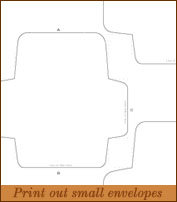
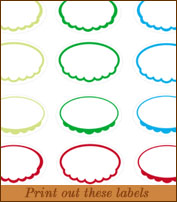
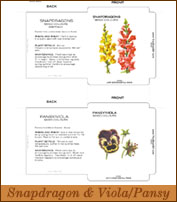
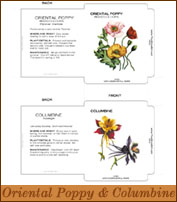
Suggestions for Use
Print the labels onto plain or sticker paper. We used plain, white sticker paper and clear sticker paper available for use with ink jet printer.
Print the envelopes onto any paper that is appropriate for your printer. We used construction paper, plain paper, colour ink jet paper and clear, thin vellum. If you are using vellum use rubber cement to seal.
